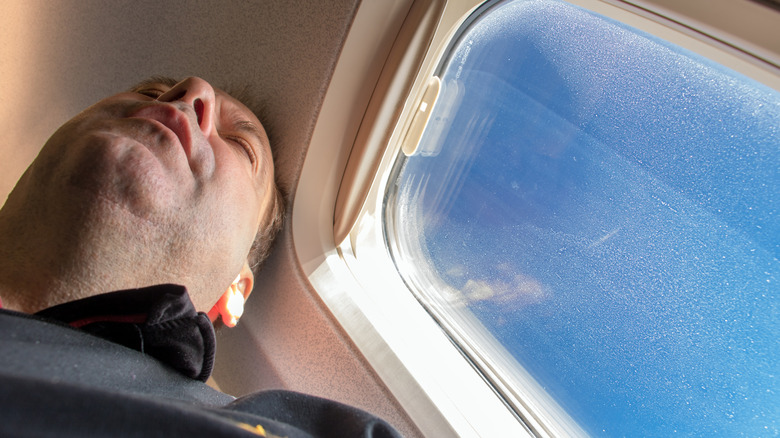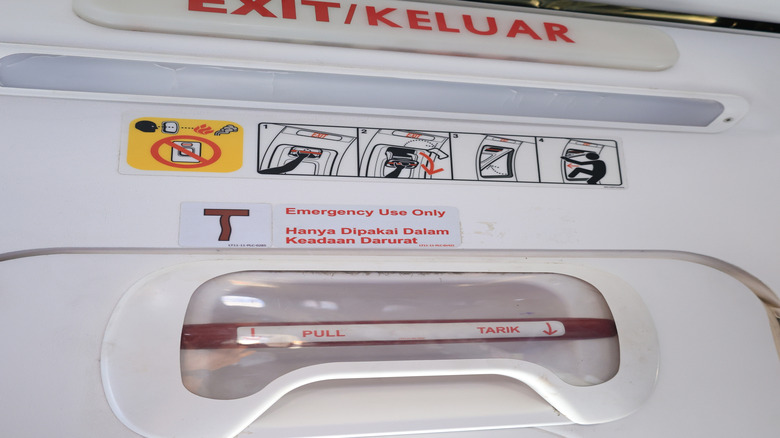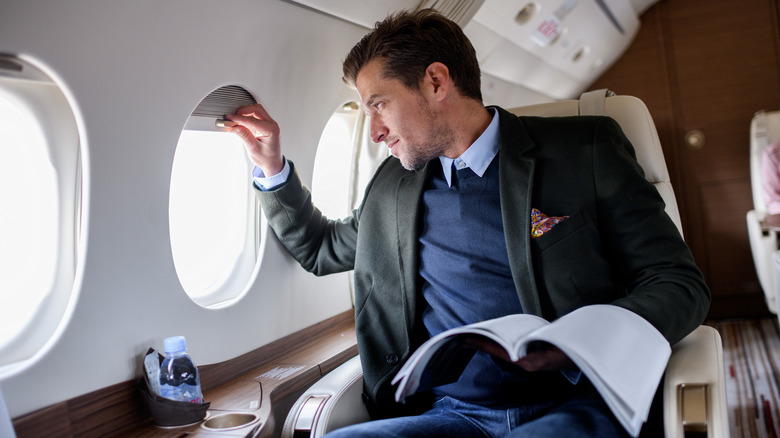What Passengers Need To Know About Sitting Near Door Plugs On Airplanes
A piece of news went viral in early 2024: It was about the case of a door-sized panel (known as a door plug) falling off midair. Specifically, January 5, 2024 was a scary day for many passengers who had boarded the Boeing 737 MAX 9 aircraft whose door plug blew off in the middle of the flight, creating a dangerous opening in the fuselage. Even though no deaths were recorded during that Alaska Airlines Flight 1282, it was no doubt an unforgettable incident for everyone onboard the plane, sparking fear as to which airlines may now be considered safe.
You're probably wondering what a door plug is. Well, it's a special panel that is used to replace an emergency exit door where such an exit door is not needed. You see, during construction, the body of an airplane has more openings than are necessary — and the unnecessary openings need to be filled. In other words, we might just call it an emergency exit that has been sealed off. From inside the plane, you'd only see a window, so even frequent flyers may not know if they've ever sat by a door plug. You may however observe the outline of a door when looking at the door plug (the sealed-off exit) from outside.
Door plugs are commonly found installed in planes like the Boeing 737 MAX 9, especially when the planes are configured in a way that has fewer passengers. The more passengers a plane has, the more emergency exits it needs. Since fewer passengers means fewer emergency exits, airlines opt for door plugs in place of full, functioning doors, helping to avoid extra weight or maintenance of those unused doors. However, the door plug has to be fitted in perfectly to avoid unexpected mishaps.
Keynotes from the Alaska Airlines door plug issue
On the fateful day in January 2024, the Alaska Airlines plane had just left Portland about six minutes earlier and was at 16,000 feet when the door plug fell off midair. The investigations have since revealed that four critical bolts had been missing on the panel, resulting in what could have been a fatal catastrophe if the plane had already gone farther up. This led the Federal Aviation Administration (FAA) to order the immediate grounding and further inspections of Boeing 737 MAX 9s.
In spite of the fact that there were no casualties, there was a loss of items. A case in point is that of a teenage passenger who, according to a CBS News report, lost his phone and his laptop — even his shirt got blown away from his body, plus he had a scratch. Kelly Bartlett, a fellow passenger on the same flight, was quoted as per the CBS News report, saying: "His seatbelt saved his life. And he lost his phone. He lost his laptop. But I'm so glad it wasn't worse. And I can't imagine being his mom in that situation. She pulled him back in. And then the flight attendants helped them find safe seats. But it is so scary."
A key takeaway here is that making sure to follow some essential flight survival tips — such as fastening seat belts, knowing to use an oxygen mask when necessary, and being mindful of which seats to choose — could be the lifesaving move that you need as a passenger on a plane. The use of seatbelts and oxygen masks especially must have been one of those acts that prevented death and reduced the level of harm recorded during the Alaska Airlines mishap.
Curious or cautious about sitting near door plugs on an airplane?
You're probably concerned about knowing where door plugs are located — whether for the sake of curiosity or just for the sake of safety. Although airlines hardly share such details, you can research the aircraft you're flying and find out where those plugs are located by carrying out some digital sleuthing.
How do you do this? You may start by checking the type of aircraft during booking. Check the flight details, and make use of sites like SeatGuru to get details of the seat maps. This way, you get to have an idea of what seats or window areas you might want to avoid on the airplane. It might be helpful to know that MAX 9 airplanes tend to have their door plugs close to row 26, just ahead of the wings, and this was the case for the Alaska Flight 1282. Even though experts have mentioned that an incident like that of the Alaska Airlines flight is rare, certainly, trying to get information about the seats doesn't hurt. After all, you can't be too conscious when it comes to taking safety measures.


